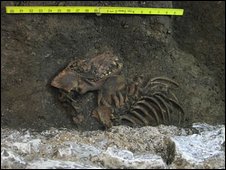Medieval finds at university dig
Roman pottery, medieval remains and 11th Century dog bones have been found at the heart of Cambridge University during an archaeological dig.
The dig has been taking place beneath a tearoom in the university’s central offices, known as the Old Schools. It was one of the events marking the 800th anniversary of the university. Some material pre-dates its foundation in 1209 by over 150 years, and is said to be the first evidence the area was occupied by an Anglo-Saxon community.
Archaeologists have unearthed several animal bones, boundary markings and signs of quarrying, which a spokesman said suggested that in the final decades of the Saxon era the foundations of Cambridge were being laid.
Roman occupation
Richard Newman of the Cambridge Archaeological Unit said: “The site has enabled us to prove what we previously had no proof for – that by the time of the Norman Conquest there was a thriving settlement in the middle of Cambridge.” The dig has reached what would have been ground level in ancient times, even before the Saxons arrived.
Cambridge was founded by the Romans, who occupied the area on the other side of the River Cam to the university. In Anglo-Saxon times, a cluster of domestic properties began to emerge, and the dog, which appears to date back to that period, would have been a valuable ally for the family that owned it, said Mr. Newman.
“It would have been a working animal,” he said.
“A dog would also have given people security, it was useful when it came to protecting your possessions and it was cheaper than a lock.” By the time the university was founded in 1209, the area was a busy commercial centre.
